PERENNIALS > HEUCHERA > VARIETIES
Reviewed By ROY NICOL

Roy is a Professional Gardener and Horticultural Consultant, specialising in large garden year-round maintenance and garden development. He is an RHS Master of Horticulture and uses his research in the application of no-dig methods in ornamental garden settings. Roy has been a Professional Gardener for more than six years and is a member of the Chartered Institute of Horticulture, Professional Gardener's Guild and Association of Professional Landscapers (Professional Gardener).
IN THIS GUIDE
- 1) H. villosa
- 2) H. micrantha
- 3) H. americana
- 4) H. brevistaminea
- 5) H. villosa ‘Palace Purple’
- 6) H. micrantha ‘Palace Purple’
- 7) H. ‘Bella Notte’
- 8) H. ‘Autumn Leaves’
- 9) H. ‘Lipstick’
- 10) H. ‘Raspberry Regal’
- 11) H. ‘Caramel’
- 12) H. ‘Electric Lime’
- 13) H. ‘Circus’
- 14) H. ‘Paris’
- 15) H. ‘Sweet Tart’
- 16) H. Frilly ‘Alchefril’
- Other Options To Consider
- References
HEUCHERA GUIDES
These plants arrived in Great Britain in 1882.1Batts, G. (n.d.). Heucheras – their cultivation and use. Hardy Plants. Retrieved March 17, 2023, from https://www.hardy-plant.org.uk/docs/publications/journal/37b/heuc.pdf
For many decades they were appreciated only by – shall we say – plant connoisseurs, but in the past two decades Heuchera has really taken off, receiving the RHS’s Award of Garden Merit for 25 varieties.2AGM Plants. (2021b, July). Royal Horticultural Society. Retrieved March 17, 2023, from https://www.rhs.org.uk/plants/pdfs/agm-lists/agm-ornamentals.pdf

And about time, for this lovely genus has a lot going for it, as one may readily infer from my selection of the twenty-four types underneath:
1) H. villosa

One of the parent species of many popular cultivars.
It is one of those species that makes its home on woody, rocky slopes around the Appalachians in North America.
Its common name ‘Hairy Alum Root’ refers to its salient characteristic: hairy stalks and hairy leaves.
In fact, ‘villosa’ is Latin for ‘hairy’ or ‘furry’.
The pink-white florets it bears arrive very late in summer.
2) H. micrantha

Is another parent species of various varieties, and it too is native to wooden rocky slopes along North America’s Western Seaboard.
It too has hairy leaves, less so than H. villosa, and has small leaves (hence ‘micrantha’).
It has a couple of points of interest; first, the red-purple tone of the foliage, and second, the very tall nearly one-metre high peduncles which bear pink-white florets.
3) H. americana

The species that could be called ‘Basic’, for it has no very unusual characteristics.
Though immature leaves have a purple tinge, they soon become a bright ‘leafy’ green.
The long panicles bear florets of an indeterminate whitish colour.
This nondescript species is another woody rocky slope denizen except that it prefers the Central United States.
4) H. brevistaminea

The last species we outline for a couple of good reasons.
It is rare, and is threatened and endangered outside a very small location in Southern California.
This is a pity because it is a tough species that can thrive in inhospitable regions yet has lustrous bright green foliage and produces panicles of candy pink flowers.
5) H. villosa ‘Palace Purple’
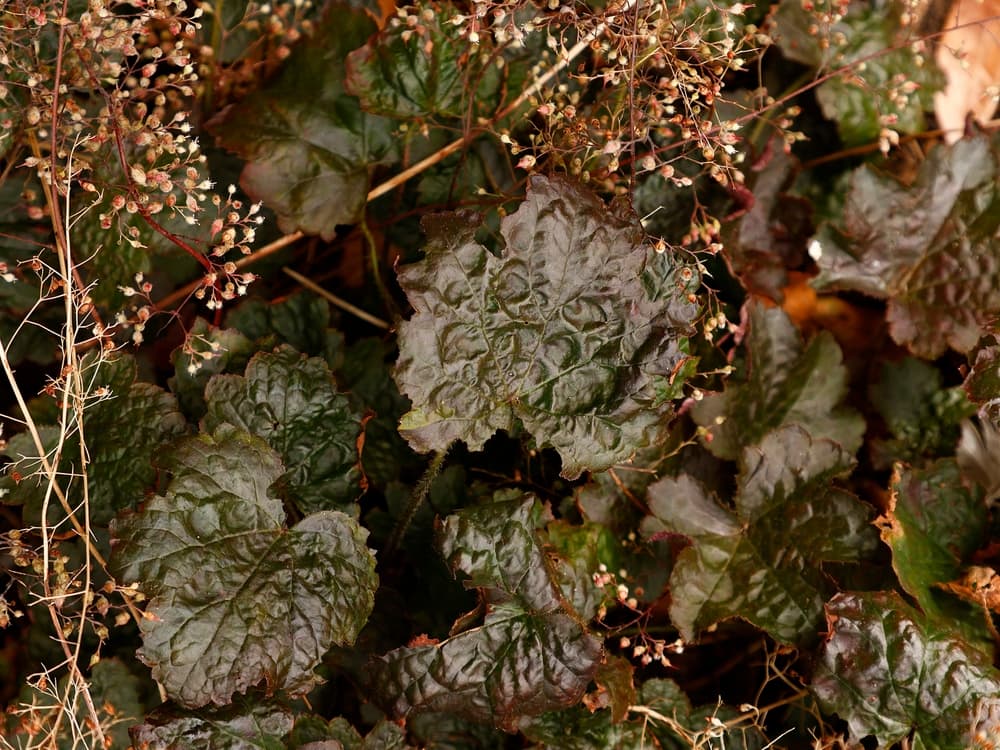
One of the most popular and widely-available Heuchera varieties, and was shortlisted for the RHS plant of the centenary for the decade 1983 to 1992.3Heuchera villosa. (n.d.). Royal Horticultural Society. Retrieved June 13, 2023, from https://www.rhs.org.uk/plants/256801/i-heuchera-villosa-i-palace-purple/details
Its deeply-lobed leaves are a rich burgundy (the plant is named after the dark burgundy brickwork at Kew Palace in the 1980’s) above which panicles of pinkish florets stand erect in summer.
Stalks and peduncles too are of a reddish purple.
The plant forms mounds of 20-30cm high and wide.
6) H. micrantha ‘Palace Purple’
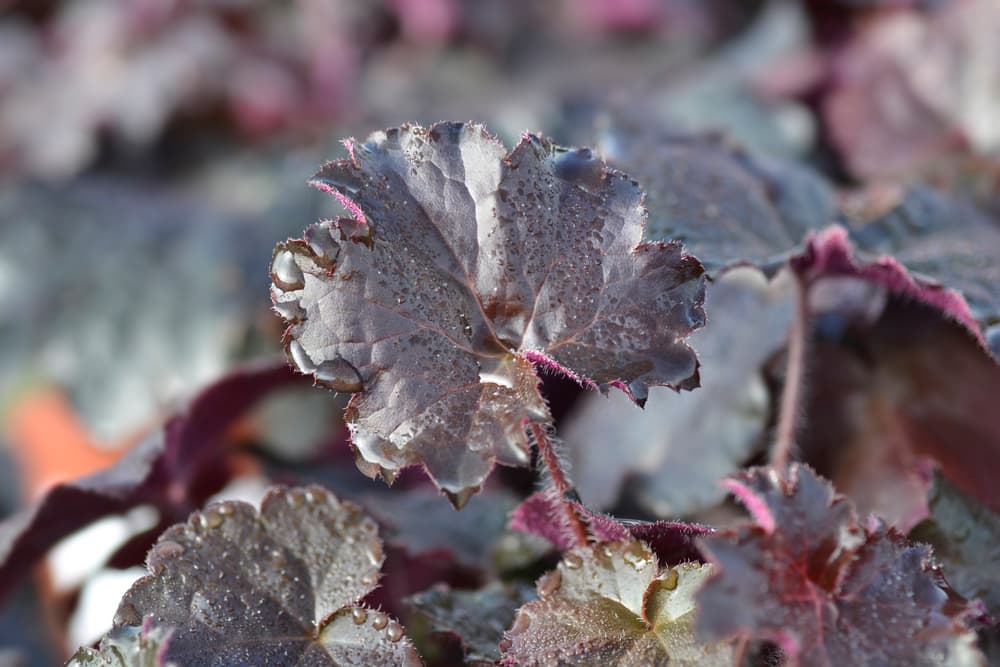
Yes, the H. micrantha species also has a ‘Palace Purple’ cultivar and oddly enough it too is an award winner, being the Perennial Plant Association’s Plant of the Year 1991.4Perennial Plant of the Year. (n.d.). Perennial Plant Association. Retrieved March 17, 2023, from https://perennialplant.org/page/PastPPOY
It too forms mounds of 20-30cm and 40 wide.
The leaves, however, can differ in colour from olive green to shades of near true purple.
It bears off-white panicles from early summer.
7) H. ‘Bella Notte’

Quite similar to the two ‘Palace Purple’ varieties in habit and height; moreover, even its gently scalloped leaves are a dark maroon-purple.
However, it outdoes them in the floral department.
This variety not only has a long blooming season from late spring clear through to early autumn, the hue of its flowers, from bright pink to cherry red, is markedly more attractive.
8) H. ‘Autumn Leaves’
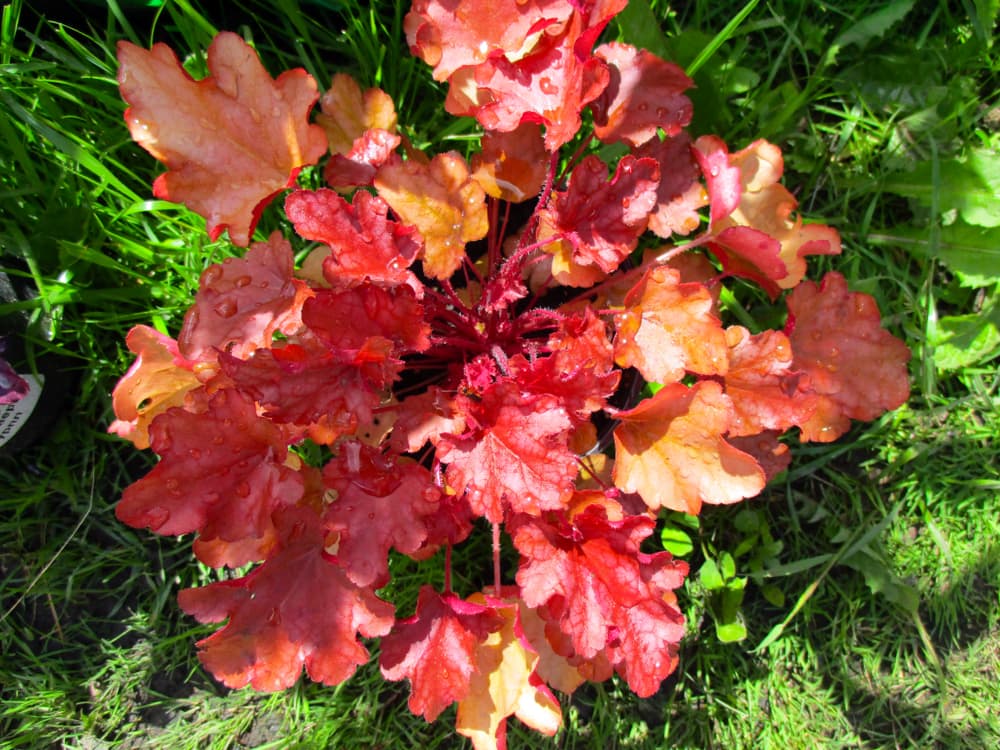
Not suitably named; it would be more apropos to call it ‘Seasonal Leaves’ – for in spring the attractively-scalloped leaves begin the show with a reddish salmon colour, turn a light grey-brown in summer, and then again change colour to deep shades of red, from vermilion and flame to ruby red.
Summer’s creamy-white flowers are truly a sideshow on this largeish shrub that is often 50 x 50 centimetres.
This plant has PBR (Plant Breeder’s Rights) protection, meaning it cannot be propagated without the PBR owner’s permission.
9) H. ‘Lipstick’

Suitably named and is also a brilliant red, except that this is a Heuchera variety that has the rare distinction of being named after its flowers!
Of a classic Lipstick Red hue, the florets are a little bigger than usual and the plant blooms profusely, and re-blooms.
The foliage makes for a wonderfully complementary backdrop in summer as the leaves are bright green with silvery dappling and marbling.
It is much broader than high, at 36cm wide by 20 tall.
It is a recipient of the RHS’s Award of Garden Merit.
10) H. ‘Raspberry Regal’

Doubling up on Heuchera varieties with the rare distinction where the flowers take centre stage, this one also bears bigger-than-average flowers on even longer peduncles that are often just shy of one metre!
Though the scalloped backdrop has some silver marbling on a brilliant green canvas, it’s all about the late-spring early-summer masses of deep, rich red blooms with this aptly-named variety.
11) H. ‘Caramel’
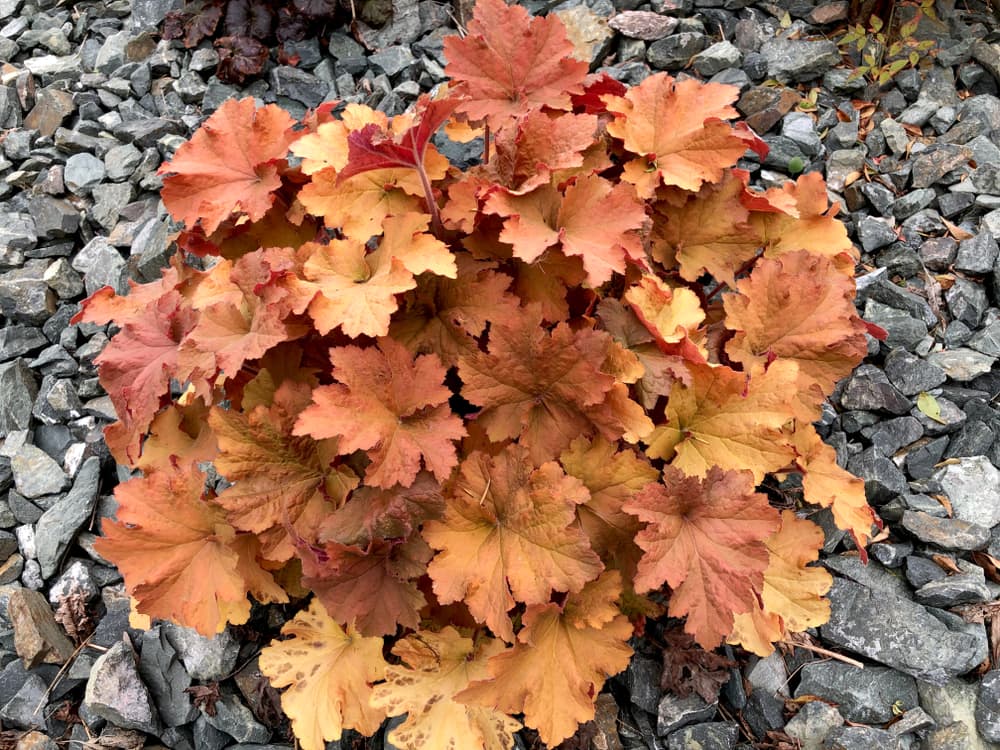
Staying with the foodstuffs theme but reverting to foliage as the main attraction, this increasingly popular clump-forming variety has very rounded, shallowly-lobed leaves.
Starting off in tones of pale pink to pale orange in spring, the leaves gradually take on colour, warming up to a rich, golden caramel hue.
Tiny light pink florets make an appearance in summer.
This plant also holds PBR protection.
12) H. ‘Electric Lime’

Staying with both food and foliage, this ‘feature-packed’ variety is quite big, to begin with.
It grows to about 50cm high by about 80 wide.
The leaves have a lovely palmately-lobed shape – they start off ‘electric’ yellow with red veins, and mature to a lime green hue decorated with thick and deep veining in contrasting deep red.
It bears pedicles of especially dense florets in pure white. Adding to its ‘features’, this variety is especially tough.
13) H. ‘Circus’

Displays especially regular shallow-scalloped leaves as if they are produced from a cookie-cutter.
Though it has similar lime-green foliage with prominent blackish-red veins, it has its own twist: in the summer, bright pink florets rise above the leaves and last until the end of summer, and come autumn, the leaves change colour, also to purple-pink.
So if you’re lucky, at end-summer, start-of-autumn, you may catch colour-matching florets and foliage!
This plant also holds PBR protection.
14) H. ‘Paris’

On the small side at about 25cm high and wide, and is a clump-forming variety.
Its foliage offers a colour reversal from ‘Circus’ as the veins are prominently and broadly etched in green on a silver ground.
It bears relatively large rose pink florets on bronze-toned peduncles over a particularly long blooming season.
This disease-resistant variety is a recipient of the RHS’s Award of Garden Merit and also has PBR protection.
15) H. ‘Sweet Tart’

Only 10-12cm tall and with a mounding habit, this variety’s scalloped leaves change colour from a ‘popping’ greenish-yellow through lime-green, to which the cerise to cherry-red florets on tall panicles make a lovely and lively contrast.
This variety is a choice pick from the (trademarked) ‘Little Cuties’ range of very compact dwarf cultivars with PBR protection, which are particularly robust.
16) H. Frilly ‘Alchefril’
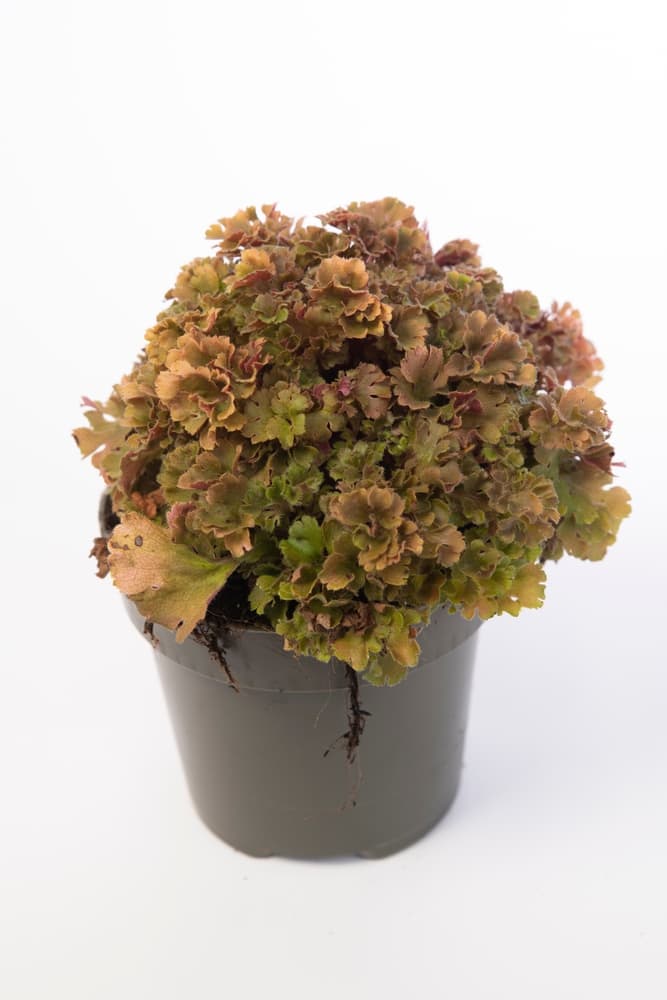
The latest variety and caused a sensation when introduced in 2021 at the Chelsea Flower Show.5A breakthrough in heucheras – yes really! (n.d.). Royal Horticultural Society. Retrieved March 17, 2023, from https://www.rhs.org.uk/plants/plants-blogs/plants/november-2020/heuchera-frilly-alchefril
The colour ranges from caramel and light orange in summer or in the shade, to a deeper orange and even scarlet in the winter or in sun, as in the parent ‘Tangerine Wave’.
This sport’s charm is in its ‘frilly’ irregularly scalloped leaves; they are unusual in being tightly frilled.
It bears cream-coloured florets.
Other Options To Consider
There are so many heuchera varieties to choose from that we can’t end this post without giving them a little shoutout.
Here are some other beautiful cultivars to consider:
17) H. ‘Blackberry Jam’

18) H. ‘Can-Can’
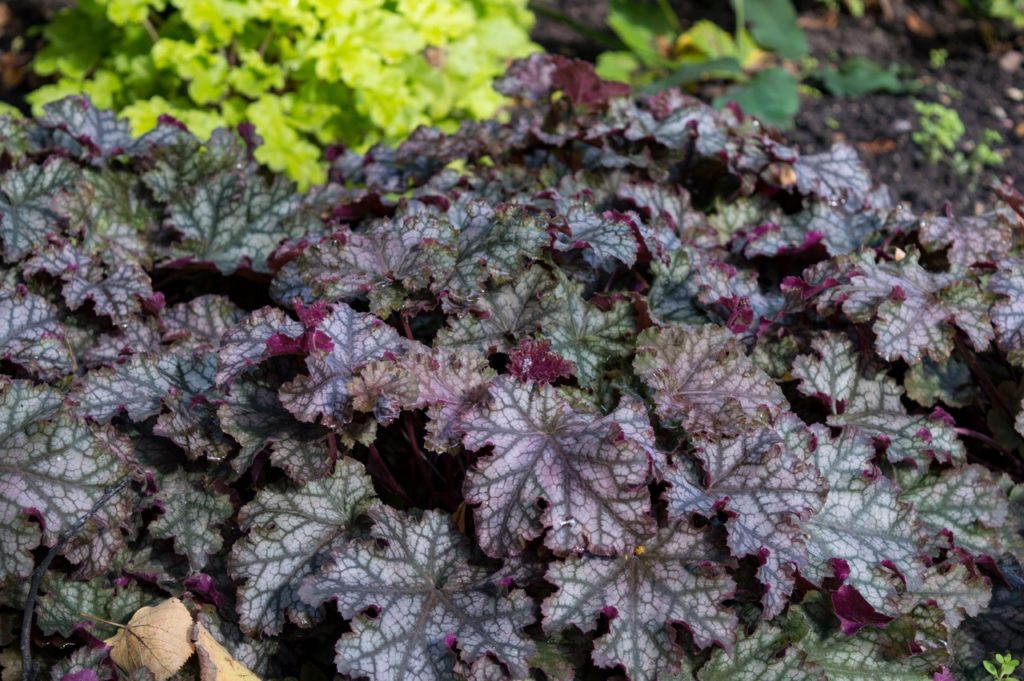
19) H. ‘Plum Pudding’
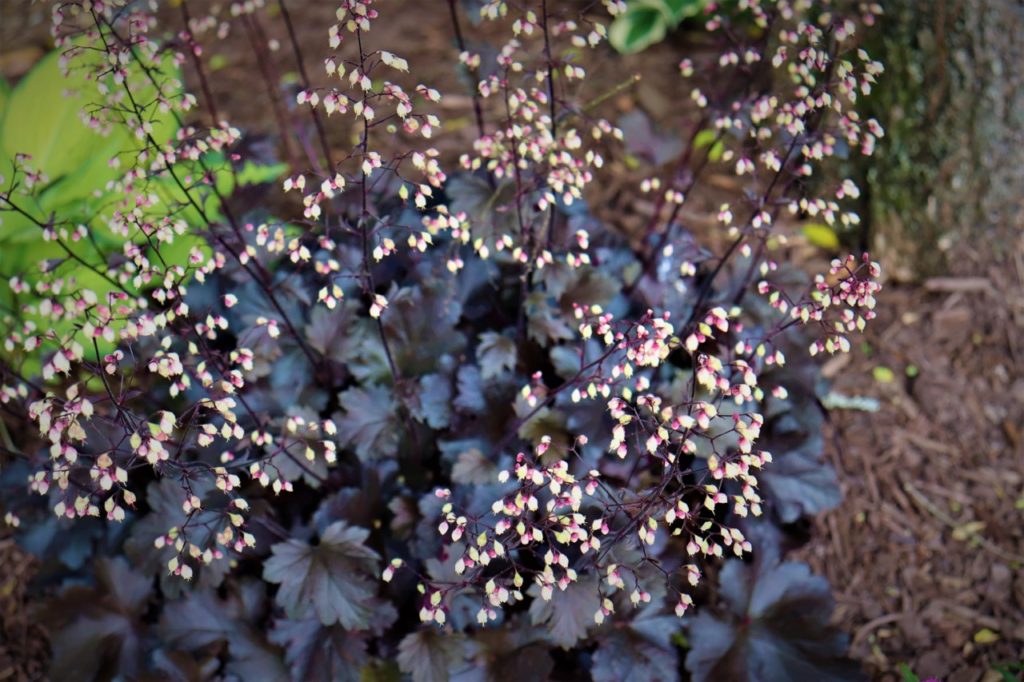
20) H. ‘Green Spice’
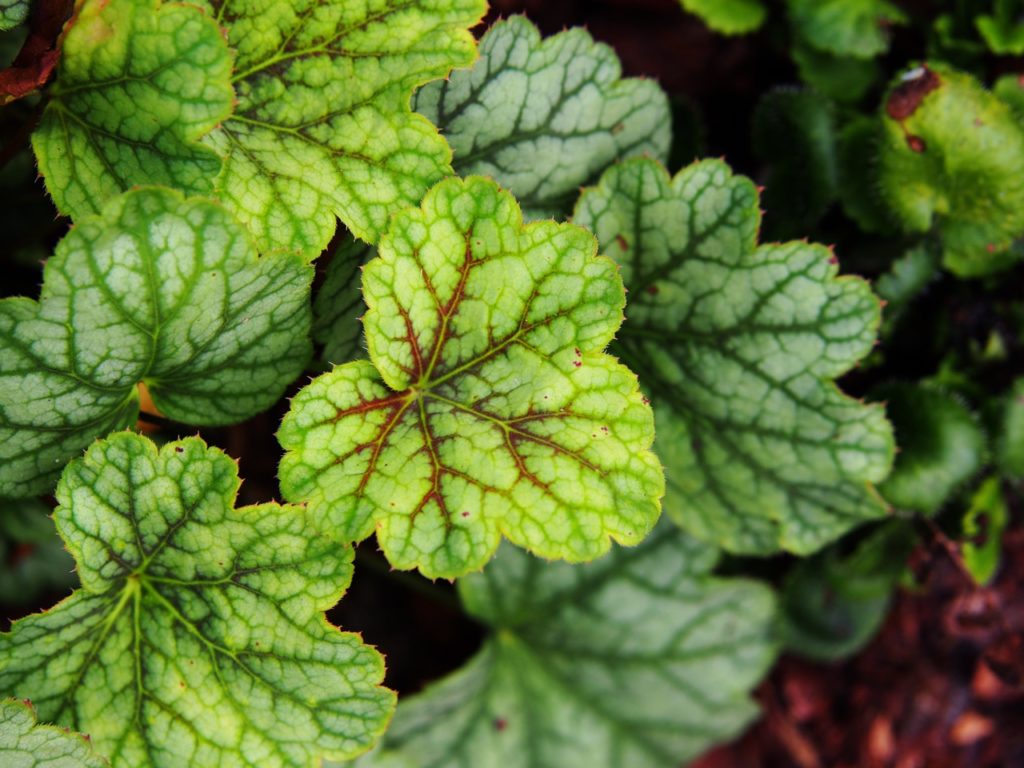
21) H. ‘Fire Alarm’
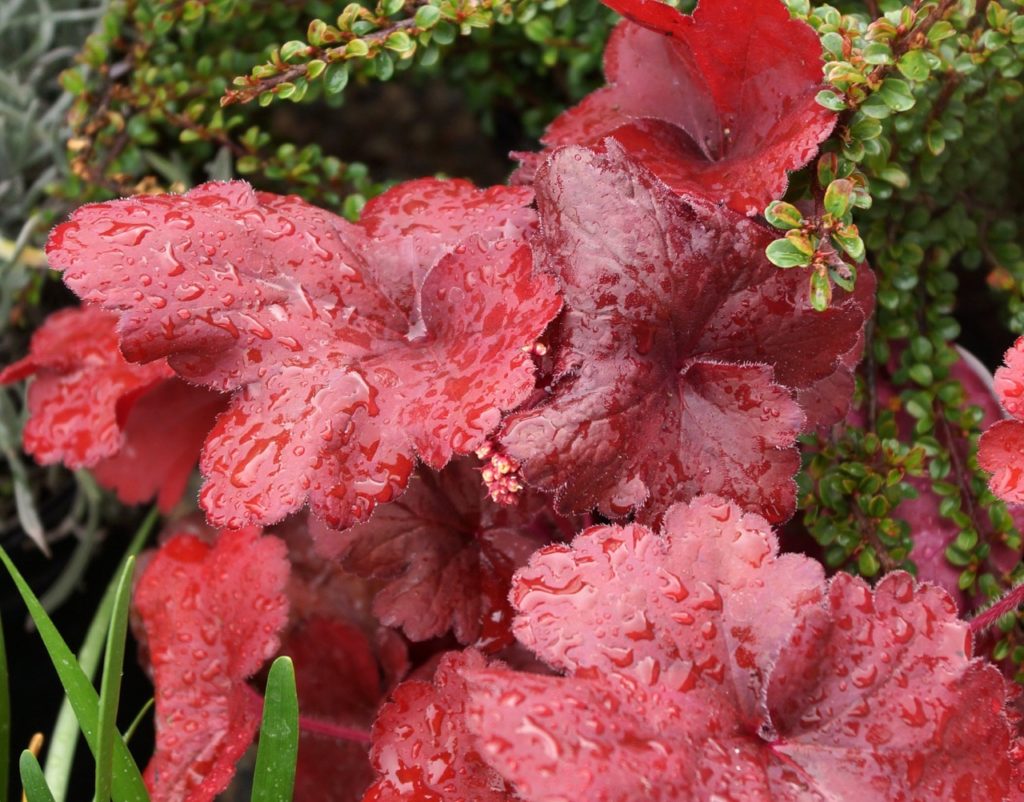
22) H. ‘Black Beauty’

23) H. ‘Silver Scrolls’
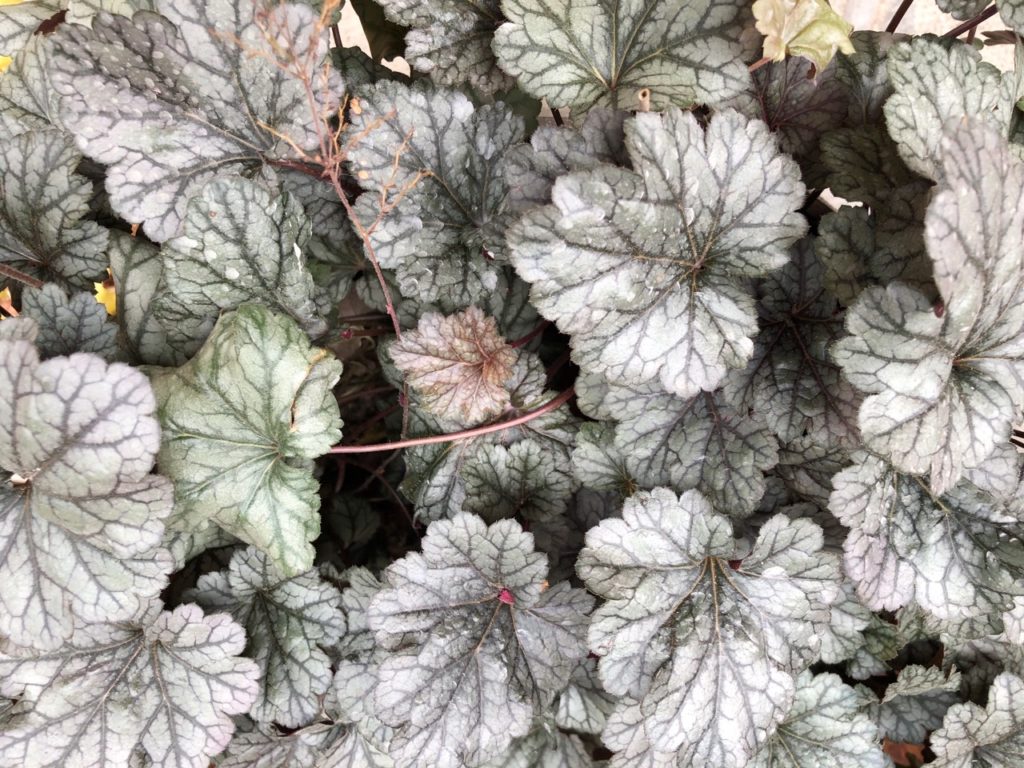
24) H. ‘Black Taffeta’
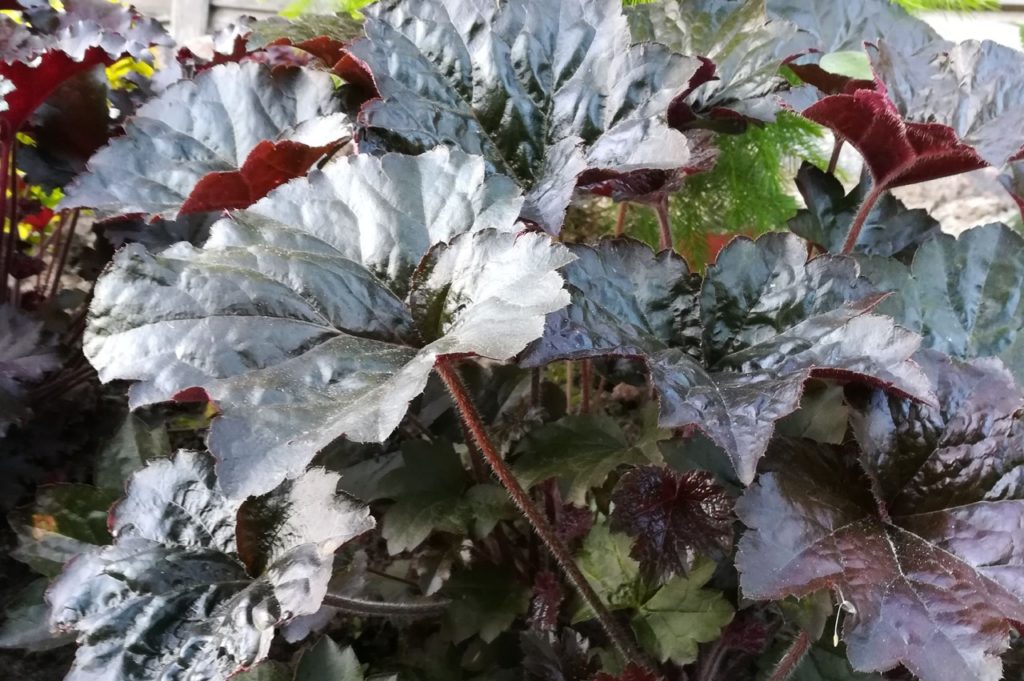
References
- 1Batts, G. (n.d.). Heucheras – their cultivation and use. Hardy Plants. Retrieved March 17, 2023, from https://www.hardy-plant.org.uk/docs/publications/journal/37b/heuc.pdf
- 2AGM Plants. (2021b, July). Royal Horticultural Society. Retrieved March 17, 2023, from https://www.rhs.org.uk/plants/pdfs/agm-lists/agm-ornamentals.pdf
- 3Heuchera villosa. (n.d.). Royal Horticultural Society. Retrieved June 13, 2023, from https://www.rhs.org.uk/plants/256801/i-heuchera-villosa-i-palace-purple/details
- 4Perennial Plant of the Year. (n.d.). Perennial Plant Association. Retrieved March 17, 2023, from https://perennialplant.org/page/PastPPOY
- 5A breakthrough in heucheras – yes really! (n.d.). Royal Horticultural Society. Retrieved March 17, 2023, from https://www.rhs.org.uk/plants/plants-blogs/plants/november-2020/heuchera-frilly-alchefril


